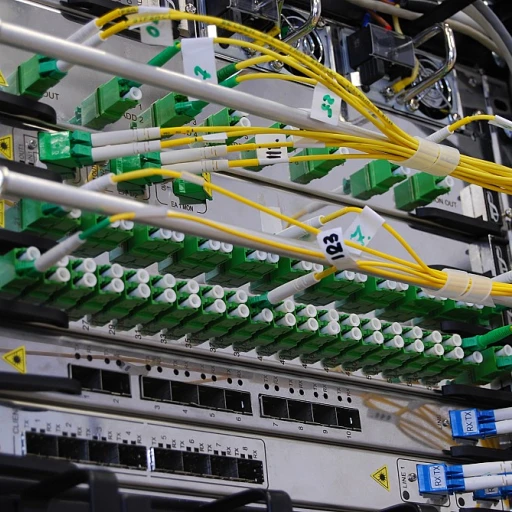
Understanding the Role of Monitoring Tools in Software Development
The Importance of Monitoring Tools in Modern Software Development
In today's fast-paced digital landscape, the role of monitoring tools in software development cannot be overstated. As applications become more complex and user expectations continue to rise, developers and businesses alike are turning to comprehensive monitoring solutions to ensure optimal performance and reliability. These tools, such as Sentry and Datadog, provide critical insights into application performance, error tracking, and infrastructure monitoring, enabling teams to swiftly identify and address issues before they impact users.
Monitoring tools are essential for maintaining the health of applications and infrastructure. They offer real-time data and alerts, allowing teams to proactively manage incidents and minimize downtime. This is particularly crucial in environments where even a minor disruption can lead to significant financial losses or damage to a company's reputation.
Furthermore, the integration of monitoring tools into the development lifecycle supports continuous improvement and innovation. By leveraging data-driven insights, teams can optimize application performance and enhance user experiences. This is where the distinction between tools like Sentry and Datadog becomes evident, as each offers unique features tailored to specific needs, from error monitoring to application performance management (APM).
For those interested in safeguarding their software innovations, addressing potential intellectual property leakage is a critical consideration. To explore this topic further, you can read more about safeguarding your innovations.
As we delve deeper into the capabilities of Sentry and Datadog, it becomes clear that choosing the right tool depends on various factors, including the specific requirements of your application and infrastructure. Whether you prioritize error tracking, performance monitoring, or comprehensive insights, understanding the strengths and limitations of each tool is key to making an informed decision.
Key Features of Sentry
Unpacking Sentry's Core Functionalities
Sentry stands out as a robust tool in the realm of error tracking and performance monitoring. It is designed to help developers identify and resolve issues in real time, ensuring that applications run smoothly and efficiently. By focusing on error monitoring, Sentry provides developers with the insights needed to improve application performance and user experience.
Error Tracking and Performance Monitoring
At the heart of Sentry's offerings is its ability to track errors effectively. This feature allows developers to pinpoint the exact location and cause of errors within their codebase. Sentry's real-time monitoring capabilities ensure that issues are identified as they occur, reducing downtime and enhancing user satisfaction. Additionally, Sentry's performance monitoring tools provide detailed insights into application performance, helping teams optimize their systems for better efficiency.
Comprehensive Monitoring and Insights
Sentry's comprehensive monitoring tools are designed to provide a holistic view of an application's health. By integrating log management and infrastructure monitoring, Sentry offers a complete solution for tracking both application and infrastructure performance. This integration allows for a seamless flow of data, enabling developers to make informed decisions based on accurate insights.
Setup and User Experience
One of the key advantages of Sentry is its user-friendly setup process. Designed with developers in mind, Sentry offers a straightforward installation and configuration process, making it accessible for teams of all sizes. The platform's intuitive interface ensures that users can easily navigate and utilize its features, enhancing the overall user experience.
Pricing and Open Source
Sentry's pricing model is flexible, catering to both small startups and large enterprises. It offers a range of plans that scale with the needs of the organization, ensuring that users only pay for the features they require. Additionally, Sentry is an open source platform, which means that developers can customize and extend its functionalities to suit their specific needs. This flexibility makes Sentry a popular choice among developers seeking a tailored monitoring solution.
For more insights on integrating risk management into software platforms, you can explore navigating the future with risk management APIs.
Exploring Datadog's Capabilities
Unveiling Datadog's Robust Capabilities
Datadog stands out as a comprehensive monitoring solution, offering a wide array of features tailored to meet the diverse needs of modern software development teams. Its capabilities extend beyond basic error tracking, providing a full stack of monitoring tools that cater to both application performance and infrastructure monitoring.
One of the key strengths of Datadog is its ability to provide real-time insights into application performance. This is crucial for teams looking to maintain optimal performance and quickly address any issues that arise. The platform excels in monitoring APM and infrastructure, offering detailed data that helps in identifying bottlenecks and optimizing resource usage.
Datadog's error monitoring and incident management features are designed to streamline the process of identifying and resolving issues. With its robust alerting system, users can set up custom alerts to be notified of any anomalies or performance dips, ensuring that problems are addressed before they impact the end-user experience.
Another standout feature is Datadog's log management capabilities. This allows teams to efficiently track and analyze logs from various sources, providing a centralized view of application and infrastructure performance. This comprehensive monitoring approach is further enhanced by Datadog's integration with numerous third-party tools, making it a versatile choice for teams using a variety of technologies.
Pricing is another aspect where Datadog offers flexibility. With a range of plans available, teams can choose a package that aligns with their specific needs and budget. This flexibility, combined with its extensive feature set, makes Datadog a compelling choice for organizations seeking a reliable and scalable monitoring solution.
In conclusion, Datadog offers a robust suite of features that cater to the needs of modern software development teams. Its focus on real-time insights, comprehensive monitoring, and flexible pricing makes it a strong contender in the realm of software monitoring tools.
Sentry vs Datadog: Feature Comparison
Feature Face-off: Sentry vs Datadog
When it comes to software monitoring tools, both Sentry and Datadog stand out with their unique offerings. While each tool excels in specific areas, understanding their features can help you make an informed decision.
Error Tracking and Monitoring
Sentry is renowned for its robust error tracking capabilities. It provides real-time insights into application errors, allowing developers to quickly identify and resolve issues. This tool is particularly effective for tracking errors in applications, offering detailed error reports and stack traces.
On the other hand, Datadog offers comprehensive monitoring that includes error monitoring as part of its full-stack capabilities. While it may not specialize solely in error tracking like Sentry, it integrates error monitoring with infrastructure and application performance monitoring (APM), providing a holistic view of your system's health.
Performance Monitoring and APM
Datadog shines in performance monitoring and APM. It provides detailed insights into application performance, helping teams optimize their systems for better efficiency. With features like real-time data analysis and infrastructure monitoring, Datadog offers a comprehensive solution for performance management.
Sentry, while primarily focused on error tracking, also offers performance monitoring features. It allows users to track application performance metrics, though its capabilities in this area are not as extensive as Datadog's.
Setup and User Experience
Both tools offer user-friendly interfaces, but their setup processes differ. Sentry is known for its straightforward setup, making it accessible for teams looking to quickly implement error tracking. Its open-source nature also allows for customization based on specific needs.
Datadog, while offering a more comprehensive setup, may require more time to configure due to its extensive features. However, once set up, it provides a seamless user experience with its intuitive dashboard and powerful data visualization tools.
Pricing and Value
Pricing is a crucial factor when choosing between Sentry and Datadog. Sentry offers a competitive pricing model, especially for teams focused on error tracking. Its pricing is based on the number of events processed, making it cost-effective for smaller teams.
Datadog's pricing reflects its comprehensive feature set. It offers various pricing tiers based on the number of hosts and features used, which can be more expensive but provides significant value for teams needing full-stack monitoring and incident management.
Conclusion: Tailoring to Your Needs
Ultimately, the choice between Sentry and Datadog depends on your specific needs. If your primary focus is error tracking and you require a tool that's easy to set up, Sentry might be the right choice. However, if you're looking for a comprehensive monitoring solution that includes APM and infrastructure monitoring, Datadog offers a robust platform that can cater to those needs.
Choosing the Right Tool for Your Needs
Evaluating Your Monitoring Needs
Choosing between Sentry and Datadog for your software monitoring needs involves a careful evaluation of what each tool offers and how it aligns with your specific requirements. Both tools provide robust features for error tracking and performance monitoring, but their strengths lie in different areas.
Consider Your Application and Infrastructure
If your focus is primarily on error monitoring and application performance, Sentry might be the more suitable choice. It excels in tracking errors and providing insights into application performance, making it a strong contender for developers who need detailed error tracking and real-time alerts. Sentry's open-source nature also allows for customization, which can be a significant advantage for teams looking to tailor their monitoring setup.
On the other hand, if your needs extend to comprehensive monitoring of infrastructure and application performance, Datadog offers a more holistic approach. With its capabilities in infrastructure monitoring, APM, and log management, Datadog provides a full-stack solution that can cater to both application and infrastructure needs. Its extensive integration options and real-time data tracking make it a versatile tool for larger, more complex environments.
Weighing Pricing and Features
Pricing is another crucial factor to consider. Sentry offers a straightforward pricing model that can be more cost-effective for smaller teams or projects focused on error tracking. Datadog, with its broader range of features, may come at a higher cost, but it provides value through its comprehensive monitoring and management capabilities.
Assessing User Experience and Setup
User experience and ease of setup are also important considerations. Sentry's user-friendly interface and straightforward setup process can be appealing for teams looking for a quick deployment. In contrast, Datadog's setup might be more complex due to its extensive features, but it offers a powerful dashboard for monitoring and alerting once configured.
Ultimately, the choice between Sentry and Datadog should be based on your specific monitoring needs, the scale of your infrastructure, and your budget. By carefully assessing these factors, you can select the tool that best supports your software development and operational goals.
Future Trends in Software Monitoring
Emerging Trends in Software Monitoring
As the landscape of software development continues to evolve, so too does the realm of software monitoring. The future of tools like Sentry and Datadog is shaped by several key trends that are redefining how developers and organizations approach error tracking and performance monitoring.
AI and Machine Learning Integration
One of the most significant trends is the integration of artificial intelligence (AI) and machine learning (ML) into monitoring tools. These technologies enhance the ability to predict and identify anomalies in real time, offering proactive insights rather than reactive alerts. For instance, AI-driven analytics can help in distinguishing between normal fluctuations and genuine performance issues, thus refining the error monitoring process.
Comprehensive Monitoring Across Full Stack
The demand for full stack monitoring is on the rise, with organizations seeking comprehensive solutions that cover everything from application performance to infrastructure monitoring. Both Sentry and Datadog are expanding their capabilities to offer more holistic views, integrating APM with infrastructure monitoring to provide a unified dashboard for tracking performance across all layers of the tech stack.
Enhanced User Experience and Customization
As user expectations grow, so does the need for monitoring tools that offer customizable dashboards and alerts. The ability to tailor the user interface and notifications based on specific needs enhances the overall user experience. Tools like Datadog offer extensive customization options, allowing teams to set up alerts and dashboards that align with their unique workflows.
Focus on Security and Compliance
With increasing concerns over data privacy and compliance, monitoring tools are placing a greater emphasis on security features. This includes robust log management and incident management capabilities that ensure data integrity and compliance with industry standards. As organizations navigate complex regulatory environments, the ability to track and manage data securely becomes paramount.
Open Source and Community-Driven Development
The open source movement continues to influence the development of monitoring tools. Community-driven projects offer flexibility and innovation, allowing users to contribute to and shape the tools they rely on. This trend is particularly evident in the growing ecosystem of plugins and integrations available for platforms like Sentry and Datadog, which enhance their functionality and adaptability.
In conclusion, the future of software monitoring is characterized by a shift towards more intelligent, integrated, and user-centric solutions. As tools like Sentry and Datadog evolve, they will continue to play a crucial role in helping organizations manage and optimize their software environments effectively.















